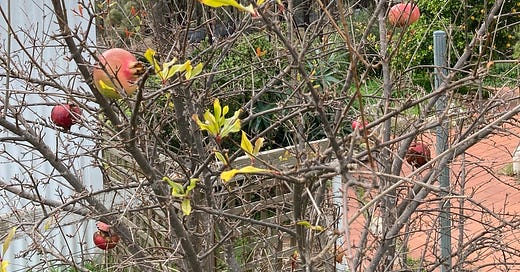In this episode, we explore how differences in location can give us different weather and different climate too.
We passed Midwinter Day here just last week. Midwinter Solstice - the shortest day, the longest night, the real start of winter. But also, oddly, the day that the pomegranate tree in the garden here first starts to push out its first new leaves of the season:
And even though we’ve already had our first frosts, it’s also still expanding the now-large pomegranate fruit (at left-of-centre in the photograph) that it sprouted from its late-autumn blossoms. The plants’ response to seasons here in south-eastern Australia is often very confusing for my otherwise very English experience.
Everything here seems strange in that way. We often talk about ‘Christmas in July’ here, because it’s the colder part of the year, as you’d expect for seasons reversed in the southern hemisphere. Yet Easter is still at the same time of year, in late March or April, but with plants recovering from the heat rather than the cold; for native trees, the time of leaf-fall here is throughout the summer, rather than in the run-up to winter.
Same plants, perhaps, but different climate. Different weather, too, with all those daily changes, and smaller less-than-daily changes, themselves making up the larger drift of climate. And all of these combined with location - the small changes of rise and fall, exposure and shelter, and more subtle, even-smaller changes - that then give rise to microclimates, even nano-climates, maybe, just from one side of a garden or garden-wall to the other.
For a northerner, even the way the sun moves here is changed from what we might expect. A young friend from England came to visit here: he couldn’t understand why he kept on getting lost in the city. He was a country lad, used to finding his way by the position of the sun and the time of day, or by where the moss grew on the dark side of trees. But he’d forgotten that down here the sun moves across the north, not the south, and even ‘clockwise’ for a sundial is the opposite direct relative to that in the north - no wonder he was getting lost!
“Location, location, location!” - the classic call of the real-estate agent! Yet in a sense, it is true, because every time we change location, we change the weather we experience, the climate, and more. Locations may stay still: but we don’t - and even small changes in location can change a lot of how we experience the world. Seems something worthwhile to notice, perhaps?




A point in case, when I moved to the southern hemisphere I missed the long summer evenings of the UK, when twilight was my favourite time of the day. Here in South Africa the absence of twilight still gets to me. As you mention each new location brings its own climate.